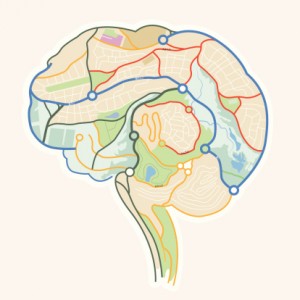Navigating the Brain’s GPS
 More than a decade ago, researchers discovered that London taxi drivers, who have to navigate one of the most byzantine street grids in the world, have atypical brain characteristics. Specifically, the posterior hippocampi—a brain region associated with spatial memory—are larger compared to other people, scientists found.
More than a decade ago, researchers discovered that London taxi drivers, who have to navigate one of the most byzantine street grids in the world, have atypical brain characteristics. Specifically, the posterior hippocampi—a brain region associated with spatial memory—are larger compared to other people, scientists found.
A new study offers some explanation for this phenomenon. The findings pinpoint the precise brain regions used in navigation, and in doing so change how scientists believed we use our brain to find our way around.
Previously, researchers had disagreed over whether the brain calculates a route or calculates the straight-line to a destination. The new research shows that both ideas are correct.
The study, according to lead scientist Hugo Spiers, indicates that our internal GPS ability is more complex than previously recognized, calculating two types of distance in separate areas of the brain. At the beginning of a journey, one region of the brain calculates the straight-line to the destination (‘the distance as a crow flies’), but during travel a different area of the brain computes the precise distance along the path to get there.
Spiers and his team at University of College London used film footage to recreate the busy streets of Soho in London inside an MRI scanner. Study participants were asked to navigate through the district, famous for its winding roads and complex junctions, while their brain activity was monitored. The researchers analyzed brain activity during the different stages of the journey: setting course for the destination, keeping track of the destination while traveling, and decision-making at street junctions.
The team found that activity in the entorhinal cortex, a region essential for navigation and memory, was sensitive to the straight-line distance to the destination when first working out how to get there. By contrast, during the rest of the journey, the posterior hippocampus, also famous for its role in navigation and memory, became active when keeping track of the path needed to reach the destination.
“Our results indicate that it is the daily demand on processing paths in their posterior hippocampus that leads to the impressive expansion in [London cab drivers’] gray matter,” Spiers said.
The results also reveal what happens in our brain when we use a GPS device or application to get to a destination. By recording brain activity when participants used GPS-like instructions to reach their goal, the researchers found that neither of the brain regions tracked the distance to the destination and in general the brain was much less active.
Results of the study, funded by the Wellcome Trust, appear in the journal Current Biology. The findings also offer insight into the underlying biology of mental health conditions that affect memory, said John Williams, head of clinical activities, neuroscience and mental health at the Wellcome Trust.
“The hippocampus and entorhinal cortex are among the first regions to be damaged in the dementia associated with Alzheimer’s disease and these results provide some explanation as to why such patients struggle to find their way and become lost,” Williams said. “Combining these findings with clinical work could enable medical benefits in the future.”





APS regularly opens certain online articles for discussion on our website. Effective February 2021, you must be a logged-in APS member to post comments. By posting a comment, you agree to our Community Guidelines and the display of your profile information, including your name and affiliation. Any opinions, findings, conclusions, or recommendations present in article comments are those of the writers and do not necessarily reflect the views of APS or the article’s author. For more information, please see our Community Guidelines.
Please login with your APS account to comment.